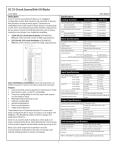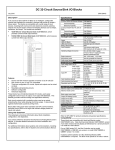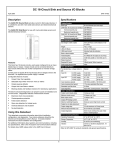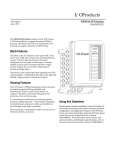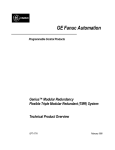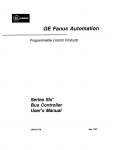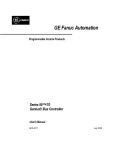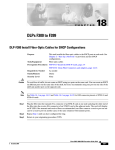Download Genius 48VDC 31-Ckt Input Block datasheet, GFK
Transcript
31 Circuit 48VDC Input Genius Block March 2010 GFK-2041A Description ___________________________________ Specifications _________________________________ A 48VDC Input Genius Block (IC660BBD040) interfaces the controller to input signals from 48V devices. The 48V system supply provides input power. The block logic supply is 24V. Catalog Numbers Block Electronics Assembly Terminal Assembly The block accepts inputs from up to 31 input devices. It does not provide input diagnostics. This block is suitable for use in Genius Modular Redundancy systems that utilize the GMR Discrete Input Autotest feature. Operation and configuration of this feature are described in the GMR User's Manual (GFK-1277). The block's 31 points accept 48V inputs. One additional logic point is used as a driver for GMR Autotest. IC660BBD040 IC660EBD040 IC660TBD040 Block Specifications Size (height x width x depth) Weight LEDs (I/O Block) LEDs (each circuit) Isolation Note: Point 16 is dedicated to the GMR Autotest feature. Point 16 must not be connected to any field device. 8.83” (22.44cm) x 3.58” (9.1cm) x 4.7” (11.94cm) 4 lbs. (1.8 kg) Unit OK, I/O Enabled Individual logic side indicators Point to point none Power, I/O to chassis ground ±500VDC (hipot test) Genius Serial Bus to Ground 250VAC to ground; (1500V hipot test); note: bus rating also depends on cable type. Heat Dissipation 11W minimum with 8 inputs 15W maximum with 31 inputs on Operating voltage Block 18 to 30 VDC (24V nominal supply) Field devices 36 to 60 VDC (48V nominal supply) Supply Ripple (maximum) 10% DC power supply current, block 150 ma. typical, 300 ma. maximum Power supply dropout times 4ms at 12 volts, 20ms at 24 volts GENIUS 48 VDC Source In/Out Input Specifications Input ON voltage relative to (DC-) Field Device Supply: 36-60V Input OFF voltage Field Device Supply: 36-60V Input impedance (typical) Input processing time (typical) Selectable input filter times Block features include: Thirty-one configurable input circuits (Points 1-15 and 17-32) 18VDC Block Supply: 22-60 volts 24VDC Block Supply: 30-60 volts 30VDC Block Supply: 39-60 volts 18VDC Block Supply: 0-14 volts 24VDC Block Supply: 0-20 volts 30VDC Block Supply: 0-27 volts with point 16 ON: 16K Ohms with point 16 OFF 6K Ohms 1.4ms (plus selectable filter delay) 1, 2, 3, 4, 5, 10, 20, 30, 40, 50, 60, 70, 80, 90, or 100ms Environmental Specifications Software configuration of block features LEDs Operating temperature 0° C to +60° C (+32° to +140° F) Storage temperature -40° to +100° C (-40° to +212° F) Block LEDs verify proper block operation and CPU communications. Individual circuit LEDs on the logic side indicate voltage present on inputs. Refer to GFK-0867 for product standards and general specifications. Configurable Features Selectable Input Filter Time from 1ms to 100ms Internal test of input states for GMR Autotest CPU Redundancy type This datasheet summarizes information about block installation, configuration, and diagnostics. Your primary reference should be the Discrete and Analog Blocks User’s Manual. It includes detailed instructions for block installation and configuration. Using this Datasheet ___________________________ For additional information about systems and communications, including bus specifications, refer to the I/O System and Communications Manual. Block Configuration Notes Points 1-15 and 17-32 must not be used as output points to For details about GMR, please refer to the GMR User’s Manual. drive loads, these points are for 48V input signals only. Point 16 must be configured as an output and set ON for nonGMR operation. Refer to the "Configuration" section later in this document. 1 31 Circuit 48VDC Input Genius Block June 2002 GFK-2041A Removing an Electronics Assembly Compatibility _________________________________ The block’s Electronics Assembly can be replaced without removing field wiring or reconfiguring the block. This block is compatible with Hand-held Monitor model IC660HHM501 only. Note that Hand-held Monitor IC660HHM501 version A will only display all references for a 32-circuit block if it is made the “Active Block”. Electronics Assembly Retaining Screws (Qty. 2) For an Series Six PLC, the Bus Controller may be model IC660CBB902 or CBB903, any version; or model IC66*CBB900 or CBB901 version 1.3 or later. Installation Instructions _________________________ Terminal Assembly Carefully inspect all shipping containers for damage. If any equipment is damaged, notify the delivery service immediately. Save the damaged shipping container for inspection by the delivery service. After unpacking the equipment, record all serial numbers. Save the shipping containers and packing material in case it is necessary to transport or ship any part of the system. Connector Pins Block Installation Genius I/O blocks are considered "open equipment" and therefore must be installed within a protective enclosure. They should be located in an area that is clean and free of airborne contaminants. There should be adequate cooling airflow. 1. Unscrew the retaining screws at the top and bottom of the block. 2. Using a Block Puller (IC660BLM507), engage the tabs in the first vent slots. Move the tool to the center of the block and squeeze the handle. 3. Pull the Electronics Assembly upward. Warning The block can be mounted right side up, or upside down. Leave at least 2 inches of space between blocks. Mount the block by drilling two screw or bolt holes for 8-32 hardware. Position the block so that the notches in the upper and lower flanges line up with the mounting holes. Mount the block using 8-32 screws. Use star washers to provide ground integrity. If power is applied to the field terminals, power is also exposed on the connector pins at the base of the Terminal Assembly, and electrical shock hazard exists. Do not touch the connector pins! Death or injury may result. Inserting an Electronics Assembly Grounding 1. The block’s mounting screws must not be used as the only means of grounding the block. Connect the green ground screw on the block to a reliable ground system using a short wire lead, minimum size AWG #12 (avg 3.3mm2 in cross-section). Align the Electronics Assembly in the guides and push down firmly. Caution Do not exert excessive force; it may damage the block. Warning 2. If unusual resistance is met, remove the Electronics Assembly. If power is applied to the block, DO NOT TOUCH THE CONNECTOR PINS! Inspect the Terminal Assembly, connector receptacle, and connector edge board (on the Electronics Assembly). Be sure the keying matches. Remove any obstacles and reinsert the Electronics Assembly. Pay close attention to the alignment of the guide pins. 3. Secure the Electronics Assembly with the screws on the top and bottom of the Terminal Assembly. If mounting screws do not make good ground connection and the ground screw is not connected to a reliable ground, the block is not grounded. Electrical shock hazard exists. Death or personal injury may result. 2 31 Circuit 48VDC Input Genius Block June 2002 GFK-2041A Input Signal Serial Bus Wiring (48V) Terminals 1 to 4 are for the serial bus. They accept one AWG #12 wire (avg. 3.3mm2 in cross-section) or two AWG #14 wires (each avg 2.1mm2). The minimum recommended wire size is AWG #22 (avg .36mm2). Terminals 1 to 4 can also accommodate spade or ring lugs up to 0.27 inch (6.85 mm) in width with a minimum opening for a #6 screw, and up to 0.20 inch (5.1 mm) depth from the screw center to the back barrier. Be sure unshielded wire ends are not longer than 2 inches (5cm). Input Typical Input Device Wiring Input 1 5 DC+ 7 DC+ 9 DC+ 14 INPUT 5 15 INPUT 6 16 INPUT 7 17 INPUT 8 18 INPUT 9 19 INPUT 10 20 INPUT 11 21 INPUT 12 24 Volt Point 16 is Reserved for GMR Autotest ONLY 22 INPUT 13 23 INPUT 14 25 GMR Autotest Input 17 SERIAL 1 2 SERIAL 2 3 SHIELD IN 4 SHIELD OUT Serial 1 Serial 2 Shield In Shield Out 30 INPUT 21 31 INPUT 22 32 INPUT 23 34 INPUT 25 35 INPUT 26 36 INPUT 27 37 INPUT 28 Input 32 38 INPUT 29 39 INPUT 30 40 INPUT31 41 INPUT 32 42 DC43 DC44 DC- 48 Volt If the block is at either end of the bus, connect a terminating resistor of the appropriate type (see the System and Communications User’s Manual for details) across its Serial 1 and Serial 2 terminals. Terminating Resistor INPUT 17 28 INPUT 19 33 INPUT 24 Do not over-torque the terminal screws. Recommended torque for all terminals on the block is 6in/lb (.678N/M). Start of Bus 24 INPUT 15 26 27 INPUT 18 29 INPUT 20 1 DC+ 12 INPUT3 13 INPUT 4 Input 15 DC+ 10 INPUT 1 11 INPUT 2 Using one of the cable types recommended in the System and Communications User’s Manual, connect the serial bus to terminals 1- 4. 6 8 45 DC46 DC- Power Disconnects It is important to wire power disconnects so that block power and input power will be removed at the same time. Either switch both supplies at the same time, or switch the DC-. End of Bus Terminating Resistor OK NO DC + Serial 1 Serial 2 Shield In Shield Out YES DC - Caution Field Wiring If I/O circuit power is not removed at the same time as block power, the block may power up when multiple inputs are activated, even though one leg of power has been removed from the block. Terminals 5 - 46 accept one AWG #14 wire (avg. 2.1mm2 cross section), two AWG #14 (2.1mm2 cross section) solid wires, or two AWG #16 (each avg. 1.3mm2 in cross section) stranded wires. If you want to disable the block without removing power from input devices, use a Block Puller to unplug the Electronics Assembly. Do not disconnect H or N to remove power. Terminals 5-9 are for the positive 24V block supply. Terminals 42-46 are common for both the block supply and the 48V input device supply. This block is an inputs-only block. Connect one terminal of a field device to the positive side of the 48V power supply and the other to the block (terminals 10-41). All I/O devices must return to the same power circuit. LEDs _______________________________________ The block's Unit OK and I/O Enabled LED’s show its operating status: Unit OK Depending on layout and current loads, positive and negative connections can be bussed and made by single wires to the block or power source. Point 16 is for GMR Input Autotest applications only. For all applications, pt. 16 MUST NOT BE connected. However, this point must be ON in the user's application logic in order to enable the input points. ON ON I/O Enabled ON OFF ON Blinking Blinking Blinking ON OFF Alternate Blinking Synchronous Blinking OFF Don’t Care Meaning Block functioning, CPU communicating Block functioning No CPU communications for 3 bus scans Block functioning, Circuit forced Circuit fault, CPU communicating Circuit fault, No CPU communications for 3 bus scans Circuit fault, Circuit forced No CPU communications - block number conflict No block power, or block faulty For each input circuit, the circuit LED indicates the presence of threshold voltage at the input terminal. 3 31 Circuit 48VDC Input Genius Block June 2002 GFK-2041A Block Operation ________________________________ Configuration _________________________________ The block has 31 identical input circuits. All inputs connect to the positive (+) side of the 48V I/O power supply. The 24V positive connects to DC+. The negative side of both supplies connects to DC-. Block IC660BBD040 has the same Electronics Assembly and firmware as the 24VDC 32-circuit Genius Source Block, IC660BBD024. Because it has the same configuration parameters, it will identify itself as a BBD024 to the Genius Hand Held Monitor and must be configured as a BBD024 at the 90-70 GBC. Since the IC660BBD040 block is an inputsonly block, it must be configured as described below. First, the block must be configured with a Hand-held Monitor to: Configured +48V as an Input I/O Terminal Assembly DC + 24V Electronics Assembly DC + Field Connections I/O 6.6K Smart Switch Input Device Test Circuit 24V and 48V common Return Control Logic 10K From I/O Point 16 DC - In a GMR system, this block can provide input diagnostics when set up for the GMR Input Autotest function, as part of its GMR configuration. A complete explanation of installation requirements and GMR Input Autotest diagnostics are included in the GMR User's Manual (GFK-1277). Device Number* Reference Address* Block I/O Type* Baud Rate* If this block is used in a non-GMR system, it provides basic block diagnostics features. Inputs and Outputs _____________________________ The block always sends 4 bytes of data each bus scan, and accepts 4 bytes of data each bus scan. Since the block is configured as a combination block the block will use 32 input references and 32 output references. Input Data Format The block broadcasts 4 bytes of input data each bus scan. Description Inputs 1 - 8 (input 1 in bit 0) 1 Inputs 9 - 16 (input 9 in bit 0) 2 Inputs 17 - 24 (input 17 in bit 0) 3 Inputs 25 - 32 (input 25 in bit 0) Specify its Block I/O Type on the Program Block ID screen. For this block, the Block I/O Type must be set to "Combination". Feature Diagnostics ____________________________________ 0 Enter its Reference Number (required only for Series Six and Series Five PLCs only). Note: If a block is configured offline, it must be properly grounded and have a 75 Ohm resistor installed across its Serial 1 and Serial 2 terminals. See the Discrete and Analog Blocks User’s Manual for instructions. The rest of the features can be configured either using a Hand-held Monitor, or by sending a Write Configuration datagram to the block from the host. DC - The block's Terminal Assembly includes an active test circuit for GMR Autotest applications. Byte # Enter its Device Number (serial bus address). Output Data The block receives 4 bytes of output data from the bus controller each bus scan. However, because this block is only compatible with input devices, the output data is not used by the block, except to set point 16 ON. The Hand-held Monitor displays the current states of 16 circuits at a time on line 4 of the Monitor Block screen. Press a function key to see the next 16 circuits. Factory Setting null Block none Block input Block Selections 0 to 31 (a number must be selected) Depends on host CPU type input, output, combination 153.6 std, 153.6 ext, 76.8, 38.4 Kbd enabled, disabled Non-GMR Application Settings 0 to 31 (a number must be selected) Depends on host CPU type combination Pulse Test for Outputs Input Filter Time Block 153.6 std enabled Block 20ms Block I/O Type Circuit I/O Type Report Faults Hold Last State Output Default State BSM Present BSM Controller ** Output Default Time Block input Circuit input 1, 2, 3, 4, 5, 10 to 100ms in 10ms steps input, output, combination input, output Circuit Circuit yes no yes, no yes, no Circuit off on, off Block Block no no yes, no yes, no Block 3 bus scans Block none Block off (for bus redundancy) 2.5 or 10 seconds none, hot standby, duplex, GMR on, off none, hot standby, duplex, GMR off Block disabled enabled, disabled enabled, disabled CPU Redundancy Duplex Default Configuration Protection Hand-held Monitor I/O Display Circuit or Block Block 153.6 std, 153.6 ext, 76.8, 38.4 Kbd disabled 1, 2, 3, 4, 5, 10 to 100ms in 10ms steps combination input (1-15, 17-32) output (16) no no point 16: ON all other points: N/A yes, no no N/A * Configured using HHM, from Program Block ID screen. ** This block cannot act as a BSM Controller. REF 17-32IO 1234567890123456 IIIIIIIIIIIIIIII 1011010101101101 4 31 Circuit 48VDC Input Genius Block June 2002 GFK-2041A Regardless of whether fault reporting is enabled, the block detects any faults on the circuit and takes appropriate actions if faults occur. The Unit OK LED blinks when a fault occurs, and a fault report is sent to a Hand-held Monitor. The fault condition must be corrected for proper operation of the block. Description of Configurable Features Pulse Test: If the block will be used in a GMR system and use the GMR Input Autotest feature, Pulse Testing should be enabled (the dafault). If the CPU requests diagnostic information from the block using Read Diagnostics datagrams, the block returns current diagnostics for all circuits, including any with CPU fault reporting disabled. If the block will NOT be used in a GMR system, Pulse Testing should be changed to disabled. Hold Last State: Not used for inputs. Input Filter Time: A filter time can be selected for inputs on the block. (The same filter will apply to all inputs). The default filter time is 20ms. Output Default State: Not used for inputs. For all applications, the Output Default State for point 16 should be ON. The block continuously samples an input for the length of the filter time period. If the input remains either on or off for the length of the Filter Time, the block recognizes its state. For example: OFF ON BSM Present: If the block is connected to a single bus or to just one trunk of a dual bus, BSM Present should be set to NO. Select YES if the block is located in a cluster connected to dual busses via a Bus Switching Module. STATE 20mS SIGNAL Sampled Inputs ON for 5mS not recognized If FILTER TIME =20mS Sampled Inputs ON for 30mS recognized by block BSM Controller: A BSM Controller is a block to which a Bus Switching Module is directly attached, which controls the BSM’s switching action. Selecting a block to be a BSM Controller block has no effect on the block’s I/O type - the block can still be configured as an inputs-only block, but circuit #1 cannot be physically used as an input. The first circuit will not be under CPU control. Sampled Inputs OFF for 3mS not recognized To change this configuration with a Hand-held Monitor, the block must first be configured for BSM PRESENT. The BSM CONTROLLER menu will not appear if BSM PRESENT is set to NO. An input filter helps reject spurious noise spikes and multiple inputs generated by the bounce of mechanical devices. In controlled, noise-free environments, signals generated by clean, solid state electronics may be unnecessarily slowed by a filter, delaying system response. In such an environment, no additional filter time is needed. Output Default Time: Not used for inputs. CPU Redundancy: This feature determines how a block will utilize output data received from single or redundant CPUs. If the block will be used in GMR system, refer to the configuration instructions in the GMR User's Manual to choose the appropriate CPU Redundancy option. Not all input blocks in a GMR system are configured for GMR Redundancy. Do not try to configure a block for GMR mode without referring to the detailed configuration instructions in the GMR User's Manual. In noisy environments, select a longer filter time to prevent noise from possibly causing erratic or unsafe system operations. The filter time can be 1, 2, 3, 4, 5, 10, 20, 30, 40, 50, 60, 70, 80, 90, or 100ms. I/O Circuit Type: An earlier configuration step selected the Block I/O type (on the Program Block ID screen). This step selects the I/O circuit types. The default Block I/O Type and I/O Circuit Type are Input. Duplex Default State: Not used for inputs. Configuration Protection: This feature can be used to protect the block’s configuration, preventing changes from the CPU or Hand-held Monitor. It can only be selected from the Hand-held Monitor. To make subsequent changes, protection must be removed again using the Hand-held Monitor. For a new block, configuration is unprotected. Before a block is used in the system, its configuration should be protected. If the block is used in a GMR system and will use the GMR Autotest feature, the Block I/O Type must be set to Combination, and Point 16 must be configured as an output. See the GMR User's Manual for configuration instructions. If the block is used in a non-GMR system, its Block I/O Type must be configured as "Combination". All circuits except 16 must be configured as inputs (the default). Point 16 must be an output, but cannot be used for a physical input device, as explained previously. Point 16 must be set ON in the user's application logic to enable input operation on the other points. It is recommended that the default state for point 16 be set to ON. This will reduce power and permit continued display of input states on point LEDs when I/O Enable is OFF. Report Faults to CPU: Fault reports to the host can be disabled or enabled for any circuit on a block. If Fault Reporting is enabled for a circuit, the block will send a message to the host if any fault occurs on that circuit. If Fault reporting is disabled, the block will not send fault reports for that circuit. 5






